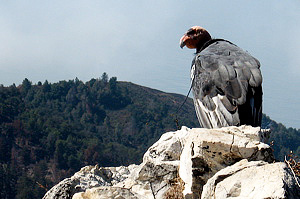Condors are like vultures; they feed on carrion. Dead animals. And many animals in the wild die when they're shot by hunters. So when an animal is shot, and then gets away from the hunter before it dies, or when a hunter guts an animal in the field and leaves the remains behind, that meat has lead fragments in it. So it's easy for California condors to ingest lead, and that can be fatal.
Lead has been shown to be hazardous to humans in even small amounts. Condors weigh about 20 pounds, so it doesn't take much lead to harm them.
The state legislature passed a law in July that bans lead bullets from areas with condors, from the San Francisco Bay Area south to San Diego.
Hunters are reluctant to simply throw away all of their lead ammunition, though, to purchase copper bullets at a higher price. And many of them are unaware of the law - or unaware that the ammo they're using is lead. Many lead bullets are topped with copper, so they look like copper bullets. This not only makes it hard for hunters to identify which of their bullets are lead-based, but it makes it difficult for state parks rangers to identify them, as well.
 Listen to the Condor Return radio report online.
Listen to the Condor Return radio report online.
36.4776 -121.185

